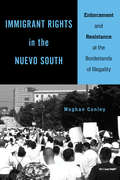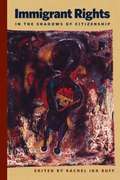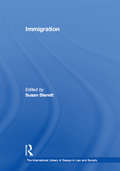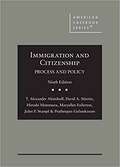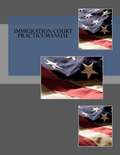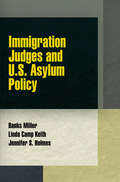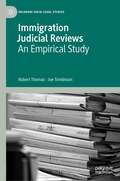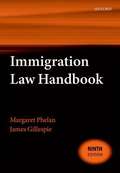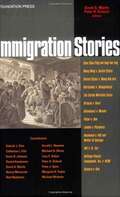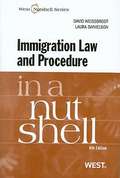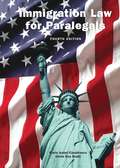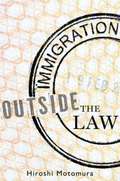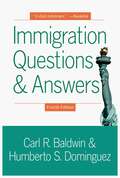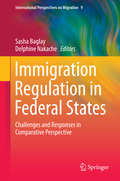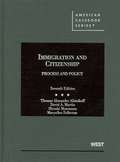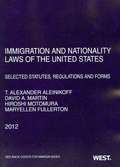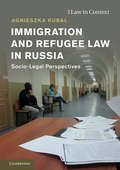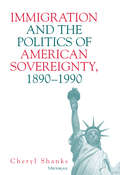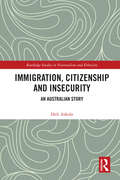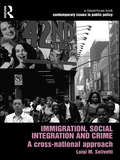- Table View
- List View
Immigrant Rights in the Nuevo South: Enforcement and Resistance at the Borderlands of Illegality
by Meghan ConleyEvery day, undocumented immigrants are rendered vulnerable through policies and practices that illegalize them. Moreover, they are socially constructed into dangerous criminals and taxpayer burdens who are undeserving of rights, dignity, and respect. Meghan Conley’s timely book, Immigrant Rights in the Nuevo South, seeks to expose and challenge these dehumanizing ideas and practices byexamining the connections between repression and resistance for unauthorized immigrants in communities across the American Southeast. Conley uses on-the-ground interviews to describe fear and resistance from the perspective of those most affected by it. She shows how, for example, the Illegal Immigration Reform and Enforcement Act in Georgia prompted marches and an action that became “a day of non-compliance.” Likewise, an “enforcement lottery” that created unpredictable threats of arrest and deportation in the region mobilized immigrants to organize and demonstrate. However, as immigrant rights activists mobilize in opposition to the criminalization of undocumented people, they may unintentionally embrace stories of who deserves to be in the United States and who does not. Immigrant Rights in the Nuevo South explores these paradoxes while offering keen observations about the nature and power of Latinx resistance.
Immigrant Rights in the Shadows of Citizenship
by Rachel BuffPunctuated by marches across the United States in the spring of 2006, immigrant rights has reemerged as a significant and highly visible political issue. Immigrant Rights in the Shadows of U. S. Citizenship brings prominent activists and scholars together to examine the emergence and significance of the contemporary immigrant rights movement. Contributors place the contemporary immigrant rights movement in historical and comparative contexts by looking at the ways immigrants and their allies have staked claims to rights in the past, and by examining movements based in different communities around the United States. Scholars explain the evolution of immigration policy, and analyze current conflicts around issues of immigrant rights; activists engaged in the current movement document the ways in which coalitions have been built among immigrants from different nations, and between immigrant and native born peoples. The essays examine the ways in which questions of immigrant rights engage broader issues of identity, including gender, race, and sexuality.
Immigrants and the Right to Stay (Boston Review Books)
by Joseph H. CarensThe Obama administration promises to take on comprehensive immigration reform in 2010, setting policymakers to work on legislation that might give the approximately eleven million undocumented immigrants currently living in the United States a path to legalization of status. Commentators have been quick to observe that any such proposal will face intense opposition. Few issues have so divided the country in recent years as immigration. <p><p>Immigrants and the Right to Stay brings the debate into the realm of public reason. Political theorist Joseph Carens argues that although states have a right to control their borders, the right to deport those who violate immigration laws is not absolute. With time, immigrants develop a moral claim to stay. Emphasizing the moral importance of social membership, and drawing on principles widely recognized in liberal democracies, Carens calls for a rolling amnesty that gives unauthorized migrants a path to regularize their status once they have been settled for a significant period of time. <p><p>After Carens makes his case, six experts from across the political spectrum respond. Some protest that he goes too far; others say he does not go far enough in protecting the rights of migrants. Several raise competing moral claims and others help us understand how the immigration problem became so large. <p><p>Carens agrees that no moral claim is absolute, and that, on any complex public issue, principled debate involves weighing competing concerns. But for him the balance falls clearly on the side of amnesty.
Immigration (The International Library of Essays in Law and Society)
by Susan SterettWhilst immigration policy is a highly controversial topic in the West, states continue to receive people who settle, whether as asylum-seekers or refugees, or as family members of existing migrants or labour migrants. Many who move violate the immigration rules either in entering a country or staying beyond the time allowed. The problems illegality entails for migrants shape much of the law and society scholarship in this area and this volume brings together the key articles which shape current thinking. The main topics covered include illegality, mercy and the language of deservingness; transnationality; family and identity; refugees and asylum-seekers.
Immigration And Citizenship: Process And Policy
by David Martin Maryellen Fullerton Hiroshi Motomura Pratheepan Gulasekaram Juliet Stumpf T. AleinikoffThe Ninth Edition of this pathbreaking casebook continues its tradition of comprehensive coverage, with problems and exercises that allow students to hone skills as counselors, litigators, and policy advisors. These virtues have become especially important in light of the many changes to immigration and citizenship law since the Eighth Edition went to press in mid-2016. This new edition opens with a reworked foundational chapter that guides students through the casebook in two key dimensions: a basic framework for constitutional immigration law, and an overview of the core administrative law principles that recently have risen to prominence in the making of immigration and citizenship law. This Ninth Edition has thoroughly updated coverage of admissions categories, unauthorized migrants, admission procedures, detention, citizenship, removability, refugees and asylum, federal enforcement, and state and local measures. The treatment of every topic is streamlined, making for a slimmer volume. In each chapter, the Ninth Edition emphasizes both core and cutting-edge issues, while optimizing teachability for a wide variety of course settings.
Immigration Court Practice Manual
by The Executive Office for Immigration ReviewThis manual is provided for the information and convenience of the general public and for parties that appear before the Immigration Courts. The manual describes procedures, requirements, and recommendations for practice before the Immigration Courts. The requirements set forth in this manual are binding on the parties who appear before the Immigration Courts, unless the Immigration Judge directs otherwise in a particular case.
Immigration Detention in the European Union: In the Shadow of the “Crisis” (European Studies of Population #22)
by Michael Flynn Izabella Majcher Mariette GrangeThis book offers a unique comparative assessment of the evolution of immigration detention systems in European Union member states since the onset of the “refugee crisis.” By applying an analytical framework premised on international human rights law in assessing domestic detention regimes, the book reveals the extent to which EU legislation has led to the adoption of laws and practices that may disregard fundamental rights and standards. While emphasizing policies and laws adopted in response to the “refugee crisis,” the volume also shows how these policies have evolved—and in many cases grown more restrictive—even as the “crisis” has begun to recede from the borders of many European countries. To sharpen awareness of contrasting developments across the region, the book’s country chapters are organised into geographic sections that reveal how variations in migration pressures have in some cases resulted in contrasting detention practices even as the EU directives have sought to harmonise immigration laws. A critical focus of the book are the evolving domestic norms related to grounds for detention, length of detention, non-custodial "alternatives to detention," the treatment of children, and conditions of detention. With its systematic and comparative assessment of immigration detention regimes across the EU, the book will be helpful for both academics and practitioners who seek a comprehensive guide to the evolution of one of today’s more important human rights dilemmas—states’ efforts to control global migration.
Immigration Judges and U.S. Asylum Policy (Pennsylvania Studies in Human Rights)
by Jennifer S. Holmes Linda Camp Keith Banks MillerAlthough there are legal norms to secure the uniform treatment of asylum claims in the United States, anecdotal and empirical evidence suggest that strategic and economic interests also influence asylum outcomes. Previous research has demonstrated considerable variation in how immigration judges decide seemingly similar cases, which implies a host of legal concerns—not the least of which is whether judicial bias is more determinative of the decision to admit those fleeing persecution to the United States than is the merit of the claim. These disparities also raise important policy considerations about how to fix what many perceive to be a broken adjudication system.With theoretical sophistication and empirical rigor, Immigration Judges and U.S. Asylum Policy investigates more than 500,000 asylum cases that were decided by U.S. immigration judges between 1990 and 2010. The authors find that judges treat certain facts about an asylum applicant more objectively than others: facts determined to be legally relevant tend to be treated similarly by judges of different political ideologies, while facts considered extralegal are treated subjectively. Furthermore, the authors examine how local economic and political conditions as well as congressional reforms have affected outcomes in asylum cases, concluding with a series of policy recommendations aimed at improving the quality of immigration law decision making rather than trying to reduce disparities between decision makers.
Immigration Judicial Reviews: An Empirical Study (Palgrave Socio-Legal Studies)
by Robert Thomas Joe TomlinsonThis book analyses how the system of immigration judicial reviews works in practice, as an area which has, for decades, constituted the majority of judicial review cases and is politically controversial. Drawing upon extensive empirical research and unprecedented research access, it explores who brings judicial review challenges against immigration decisions and why, the type of immigration decisions that are challenged, how cases proceed through the judicial review process, how cases are settled out of court, and how judicial review interacts with other legal and non-legal remedies. It also examines the quality of immigration judicial review claims and the quality of the initial administrative decisions being challenged. Through developing a novel account of the operation of the immigration judicial review system in practice and the lived experience of it by judges, representatives, and claimants, this book adds a significant new perspective to the wider understanding of judicial review.
Immigration Law Handbook
by Margaret Phelan James GillespieNow in its ninth edition, the Immigration Law Handbook continues to bring together all the key materials relevant to Immigration and Asylum Law in one volume, providing an essential reference tool for those working in the area. This new edition includes the text of the Immigration Act 2014 which will make substantial changes to existing legislation, in particular the 1971 and 2002 acts and restricts access to housing and other services. Other texts provided include the new Dublin III EU regulations and recent UNHCRguidelines on refugee claims. This coverage of recent new legislation sits alongside existing important legislation to maintain the strengths of the handbook as a reference tool whilst providing the reader with up-to-date access to all new developments in a single volume. The Immigration Law Handbook has established itself as the standard in the field and has become an invaluable resource for immigration practitioners including Asylum and Immigration Tribunal judges and barristers, and solicitors and caseworkers working in immigration, asylum, and human rights law.
Immigration Law Pocket Field Guide 2015 Edition
by The Editors at the LexisNexisThis latest edition of the Immigration Law Pocket Field Guide from LexisNexis is an essential item in the pocket of any law enforcement professional who deals with immigration law on a regular basis.
Immigration Law Stories (Law Stories Ser.)
by David Martin Peter SchuckThis publication includes cases that depict the Supreme Court’s broad deference to the political branches in the immigration realm, the so-called “plenary power doctrine.” Selected cases are presented in chronological order, beginning with the Supreme Court’s consideration of the Chinese Exclusion Acts of the 1880s and 1890s. The book then examines how the Cold War tested the constitutional limits of the government’s plenary power over immigration, and how “phantom constitutional norms” were later used to defeat the government’s broadest claims. Other cases explore the immigration enforcement system and the difficulty of balancing the demands of enforcement against other societal goals.
Immigration Law and Procedure in a Nutshell (6th Edition)
by David Weissbrodt Laura DanielsonThis compact, comprehensive title offers an expert overview of the history, constitutional authority, statutory provisions, regulations, structure, procedure, administrative process, and ethical principles of immigration law and practice.
Immigration Law for Paralegals
by Gloria Roa Bodin Maria Isabel CasablancaImmigration Law for Paralegals is an indispensable and practical guide on U. S. immigration, citizenship and visa procedures for instructing and training students or anyone interested in a career as an immigration paralegal or legal assistant. This fourth edition updates and expands the third, including coverage of Provisional Unlawful Presence Waiver and DACA (Deferred Action for Childhood Arrivals). Contents of Immigration Law for Paralegals include: interviewing, gathering information, case management and document preparation techniques; analysis of temporary and permanent employment visas; analysis of family-based petitions, political asylum and naturalization; as well as samples of completed applications, a glossary of terms and useful appendices. Each visa category is set forth in a clear and concise manner, with real-life and hypothetical situations at the end of each chapter, allowing students to visualize actual problems and issues that arise when processing a case. Further, in responding to the hypothetical situations, students will look to the United States immigration statutes, rules and regulations and precedent and administrative policies to resolve issues. Additionally, each section contains a completed sample application, definition of legal terms, and exercises modeled after tasks paralegals may encounter on the job, including the preparation of relative petitions (Form I-130) and the adjustment of a status package (Forms I-485, G-325A, I-131, I-765, I-864A, and G-28). In keeping with the concise format of each chapter, excerpts from Federal, AAO, and BIA decisions will be cited or footnoted where relevant. The Glossary and Appendices include Immigration Law resources; USCIS Local, Regional and Service Center addresses; questions and answers for the naturalization exam; blank USCIS forms; Credential Evaluation sample request forms and a list of agencies; sample USCIS color photograph specifications, sample medical form (I-688); and IRS Individual Tax ID Number Request (SS-4). The fourth edition includes a CD with fillable PDF forms.
Immigration Law for Paralegals (3rd Edition)
by Gloria Roa Bodin Maria Isabel CasablancaImmigration Law for Paralegals is an indispensable and practical guide on U.S. immigration, citizenship and visa procedures for instructing and training students or anyone interested in a career as an immigration paralegal or legal assistant. The new edition has a new chapter on court litigation which also includes writs of mandamus and habeas corpus with federal courts.
Immigration Outside the Law
by Hiroshi MotomuraThe main aim of the book is to offer a way to think about why immigration law is an area of ambivalence and disagreement and to assess and suggest responses to unauthorized migration.
Immigration Questions & Answers
by Carl R. Baldwin Humberto S. DominguezA Comprehensive, User-Friendly Guide for Anyone Planning to Live Temporarily or Permanently in the United States The process of acquiring and retaining the right to visit or live in the United States is an interesting and complex subject. US immigration laws have not changed very much during the Trump administration, and yet the experience of immigrating to the United States has definitely been affected by it. In this concise primer, first conceived and designed as a how-to resource for would-be &“green card&” holders in the 1990s, the process of getting and keeping a visa is explained and updated in this new edition. In simple terms, the authors provide a breakdown of the most important topics in this area with useful examples. With over thirty years of experience practicing law, co-author Humberto S. Dominguez adds valuable insights and observations to this increasingly important topic. The road to legal residence in the United States can be a tricky and elusive endeavor. Immigration Questions & Answers, Fourth Edition, will guide you every step of the way, with a down-to-earth approach and invaluable advice. Chapters cover topics such as:Obtaining a short-term visaPolitical asylumTemporary Protected StatusDACA for DreamersThe visa lotteryHelping your spouse get a green cardRemoving conditions on residenceVisa processingWays to become a US citizen Persons who hope to visit or live in the United States and even lawyers unfamiliar with immigration law and practice will benefit from this basic guide. People facing particular difficulties in this area, who may ultimately need the assistance of an immigration lawyer, will also benefit from learning the bare essentials.
Immigration Regulation in Federal States
by Sasha Baglay Delphine NakacheThe book examines the phenomenon of immigration federalism: its main characteristics, why and how it has developed, its implications for immigration systems (in general) and non-citizens' rights (in particular). The book introduces the reader to theoretical perspectives on immigration federalism through three sets of literature - federalism, governance and non-citizens' rights - that provide a necessary framework for understanding immigration federalism's multiple facets and impacts. It also offers an analysis of immigration federalism through case studies of six jurisdictions: Australia, Canada, Germany, Switzerland, the EU and the US. Despite increased sub-national activity in immigration regulation in several federal states, very little research has been dedicated so far to comparing how federal states deal with immigration federalism. Comparative studies on the human rights implications of immigration federalism have received even less attention. This book seeks to fill the gap in this area and is an important contribution to the field, providing the reader with a better understanding of the complex issues surrounding immigration federalism and its impact on non-citizens.
Immigration and Citizenship: Process and Policy (7th Edition)
by David A. Martin Maryellen Fullerton T. Alexander Aleinikoff Hiroshi MotomuraThe seventh edition of this pioneering casebook continues its tradition of comprehensive coverage, with problems and exercises that allow students to hone skills as counselors, as litigators, and as policy advisors. At the same time, the casebook situates immigration and citizenship law within broader contexts of constitutional and administrative law as well as current political debates. This new edition is reorganized for more efficient coverage, with an introductory chapter on immigration history; treatment of unauthorized migration alongside lawful admissions; consolidated treatment of inadmissibility and deportability; reworked materials on state and local enforcement; and thorough redesign of materials on criminal convictions.
Immigration and Nationality Law: Problems and Strategies
by Lenni B. Benson Lindsay A. Curcio Veronica M. Jeffers Stephen W. Yale-LoehrImmigration and Nationality Law: Problems and Strategies introduces the reader to the legal concepts and experience of practicing immigration law. This book is designed for both law students and attorneys as it covers not only statutory provisions and key immigration law cases, it also provides an understanding to the many government agencies involved in the immigration process and how to navigate the wide variety of adjudications that are central to the U.S. immigration system.
Immigration and Nationality Laws of the United States: Selected Statutes, Regulations and Forms 2012
by Thomas Alexander Aleinikoff David A. MartinThis book serves as a one-stop source for the most important federal legislation affecting immigration and naturalization, supplementing any teaching materials on the subject. With its consistent timeliness and reasonable pricing, this publication is a staple in classrooms nationwide.
Immigration and Refugee Law in Russia: Socio-Legal Perspectives (Law in Context)
by Agnieszka KubalImmigration and Refugee Law in Russia confronts the issue of access to justice and the realisation of human rights for migrants and refugees in Russia. It focuses on everyday experiences of immigration and refugee laws and how they work 'in action' in Russia. This investigation presupposes that the reality is much more complex than is generally assumed, as it is mediated by peoples' varied positionalities. Agnieszka Kubal's primary focus is on people, their stories and experiences: migrants, asylum seekers, refugees, immigration lawyers, Russian judges, and the Federal Migration Service officers. These actors speak with different voices, profess different ideologies, and hold opposite worldviews; what they hold in common is their importance to our understanding of migration processes. By this focus on individual views and opinions, Kubal highlights the complexity and nuance of everyday experiences of the law, breaking away from the portrayal of Russia as a legal and ideological monolith.
Immigration and the Politics of American Sovereignty, 1890-1990
by Cheryl ShanksWhat does it mean to be an American? The United States defines itself by its legal freedoms; it cannot tell its citizens who to be. Nevertheless, where possible, it must separate citizen from alien. In so doing, it defines the desirable characteristics of its citizens in immigration policy, spelling out how many and, most importantly, what sorts of persons can enter the country with the option of becoming citizens. Over the past century, the U.S. Congress argued first that prospective citizens should be judged in terms of race, then in terms of politics, then of ideology, then of wealth and skills. Each argument arose in direct response to a perceived foreign threat--a threat that was, in the government's eyes, racial, political, ideological, or economic. Immigration and the Politics of American Sovereignty traces how and why public arguments about immigrants changed over time, how some arguments came to predominate and shape policy, and what impact these arguments have had on how the United States defines and defends its sovereignty. Cheryl Shanks offers readers an explanation for immigration policy that is more distinctly political than the usual economic and cultural ones. Her study, enriched by the insights of international relations theory, adds much to our understanding of the notion of sovereignty and as such will be of interest to scholars of international relations, American politics, sociology, and American history.
Immigration, Citizenship and Insecurity: An Australian Story (Routledge Studies in Nationalism and Ethnicity)
by Heli AskolaImmigration, Citizenship and Insecurity: An Australian Story explores how Australia’s policies on migration and nationality have shaped citizenship and social inclusion.The book examines the historical and contemporary intersections of citizenship, migration and insecurity, analysing key issues such as the prioritisation of economic utility in migration policy, cultural expectations placed on newcomers and the role of migrants in political debate. It critically assesses Australia’s responses to challenges such as demographic ageing, cultural diversity and erosion of political authority. The impact of emergency measures during the COVID-19 pandemic is also explored, revealing the fragility of citizenship protections in times of crisis.This book is an essential resource for scholars, policy-makers and professionals in migration studies, political science and public policy, as well as anyone interested in the evolving dynamics of citizenship and migration in Australia and beyond.
Immigration, Social Integration and Crime: A Cross-National Approach (Contemporary Issues in Public Policy)
by Luigi M. SolivettiThe problem of social control has constituted the acid test for the entire issue of immigration and integration. But whilst recent studies show that the crime rate for non-nationals is three, four or more, times higher than that of the country’s 'own' citizens, academic interest in these statistics has been inhibited by the political difficulties they raise. Immigration, Social Integration and Crime addresses this issue directly. Providing a thorough analysis of immigration and crime rates in all of the main European countries, as well as examining the situation in the US, Luigi M. Solivetti concludes that the widespread notion that a large non-national population produces high crime rates must be rejected. Noting the undeniably substantial, but significantly variable, contribution of non-nationals to crime statistics in Western Europe, he nevertheless goes on to analyze and explain the factors that influence the relationship between immigration and crime. It is the characteristics of the 'host' countries that are shown to be significantly associated with non-nationals’ integration and, ultimately, their involvement in crime. In particular, Solivetti concludes, it is 'social capital' in the host societies – comprized of features such as education, transparency, and openness – that plays a key role in non-nationals’ integration chances, and so in their likelihood to commit crime. Supported by extensive empirical data and statistical analysis, Immigration, Social Integration and Crime provides an invaluable contribution to one of the most pressing social and political debates – in Europe, and elsewhere.
